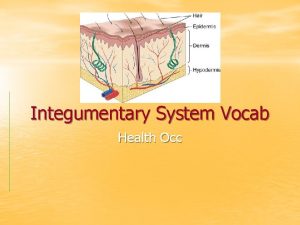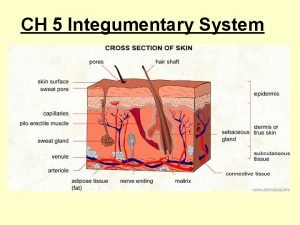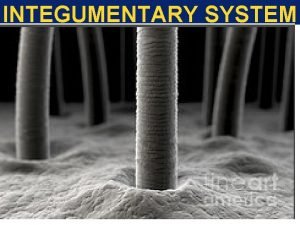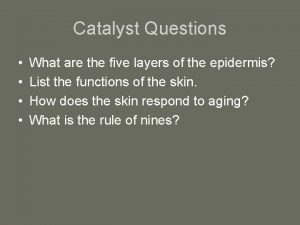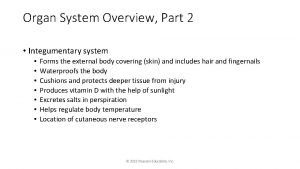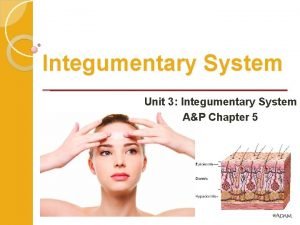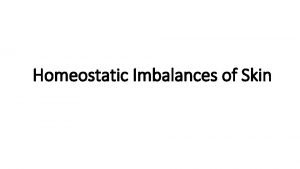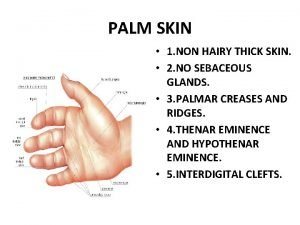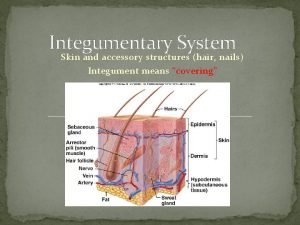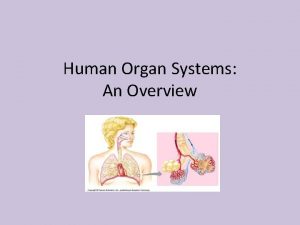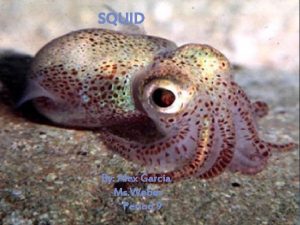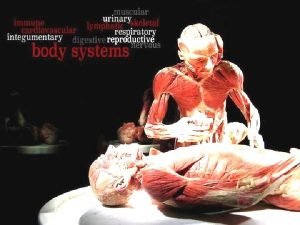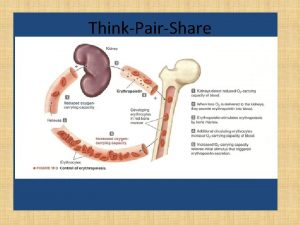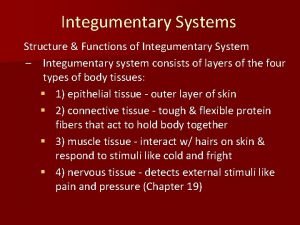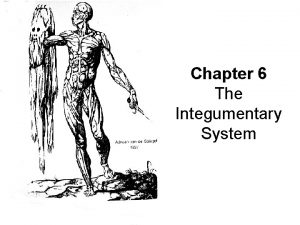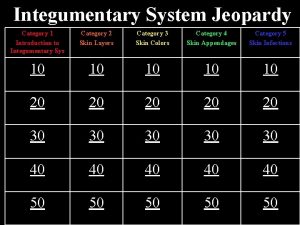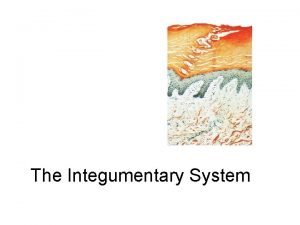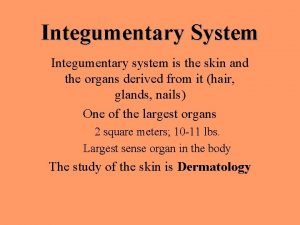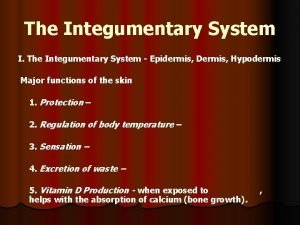THE INTEGUMENTARY SYSTEM Introduction to the Integumentary System













































- Slides: 45

THE INTEGUMENTARY SYSTEM

Introduction to the Integumentary System § The integument is the largest system of the body § 16% of body weight § 1. 5 to 2 m 2 in area § The integument is made up of two parts < Cutaneous membrane (skin; epidermis and dermis) < Accessory structures (hair, nails, glands) Copyright © 2009 Pearson Education, Inc. , publishing as Pearson Benjamin Cummings

Introduction to the Integumentary System The Components of the Integumentary System. Copyright © 2009 Pearson Education, Inc. , publishing as Pearson Benjamin Cummings

Introduction to the Integumentary System § Functions of Skin § Protects underlying tissues and organs § Excretes salts, water, and organic wastes (glands) § Maintains body temperature (insulation and evaporation) § Synthesizes vitamin D 3 § Stores lipids § Detects touch, pressure, pain, and temperature Copyright © 2009 Pearson Education, Inc. , publishing as Pearson Benjamin Cummings

Epidermis § Perspiration § Insensible perspiration § Interstitial fluid lost by evaporation through the stratum corneum § Sensible perspiration § Water excreted by sweat glands § Dehydration results: – from damage to stratum corneum (e. g. , burns and blisters [insensible perspiration]) – from immersion in hypertonic solution (e. g. , seawater [osmosis]) Copyright © 2009 Pearson Education, Inc. , publishing as Pearson Benjamin Cummings

Epidermis § Hydration § Results from immersion in hypotonic solution (e. g. , freshwater [osmosis]) § Causes swelling of epithelial cells, evident on the palms and soles Copyright © 2009 Pearson Education, Inc. , publishing as Pearson Benjamin Cummings

Skin Color § Skin color is influenced by § Two pigments § Carotene: – orange-yellow pigment – found in orange vegetables – accumulates in epidermal cells and fatty tissues of the dermis – can be converted to vitamin A § Melanin: – – yellow-brown or black pigment produced by melanocytes in stratum germinativum stored in transport vesicles (melanosomes) transferred to keratinocytes § Blood circulation (red blood cells) Copyright © 2009 Pearson Education, Inc. , publishing as Pearson Benjamin Cummings

Skin Color Melanocytes. Copyright © 2009 Pearson Education, Inc. , publishing as Pearson Benjamin Cummings

Skin Color Skin Cancers. Copyright © 2009 Pearson Education, Inc. , publishing as Pearson Benjamin Cummings

Skin Color § Function of Melanocytes § Melanin protects skin from sun damage § Ultraviolet (UV) radiation § Causes DNA mutations and burns that lead to cancer and wrinkles § Skin color depends on melanin production, not number of melanocytes Copyright © 2009 Pearson Education, Inc. , publishing as Pearson Benjamin Cummings

Skin Color § Capillaries and Skin Color § Oxygenated red blood contributes to skin color § Blood vessels dilate from heat, skin reddens § Blood flow decreases, skin pales § Cyanosis § Bluish skin tint § Caused by severe reduction in blood flow or oxygenation Copyright © 2009 Pearson Education, Inc. , publishing as Pearson Benjamin Cummings

Skin Color § Illness and Skin Color § Jaundice § Buildup of bile produced by liver § Yellow color § Addison disease § A disease of the pituitary gland § Skin darkening § Vitiligo § Loss of melanocytes § Loss of color Copyright © 2009 Pearson Education, Inc. , publishing as Pearson Benjamin Cummings

Vitamin D 3 § Epidermal cells produce cholecalciferol (vitamin D 3) § In the presence of UV radiation § Liver and kidneys convert vitamin D 3 into calcitriol § To aid absorption of calcium and phosphorus § Insufficient vitamin D 3 § Can cause rickets Copyright © 2009 Pearson Education, Inc. , publishing as Pearson Benjamin Cummings

Vitamin D 3 Rickets. Copyright © 2009 Pearson Education, Inc. , publishing as Pearson Benjamin Cummings

The Dermis § Is located between epidermis and subcutaneous layer § Anchors epidermal accessory structures (hair follicles, sweat glands) § Has two components § Outer papillary layer § Deep reticular layer Copyright © 2009 Pearson Education, Inc. , publishing as Pearson Benjamin Cummings

The Dermis § Dermatitis § inflammation of the papillary layer § Caused by infection, radiation, mechanical irritation, or chemicals (e. g. , poison ivy) § Characterized by itch or pain § Contusion: Damage to blood vessels resulting in “black–and–blue” bruising Copyright © 2009 Pearson Education, Inc. , publishing as Pearson Benjamin Cummings

The Dermis § Skin Damage § Sagging and wrinkles (reduced skin elasticity) are caused by § § Dehydration Age Hormonal changes UV exposure § Stretch Marks § Thickened tissue resulting from excessive stretching of skin due to: – pregnancy – weight gain Copyright © 2009 Pearson Education, Inc. , publishing as Pearson Benjamin Cummings

The Dermis § Lines of Cleavage § Collagen and elastic fibers in the dermis § Are arranged in parallel bundles § Resist force in a specific direction § Lines of cleavage establish important patterns § A parallel cut remains shut, heals well § A cut across (right angle) pulls open and scars Copyright © 2009 Pearson Education, Inc. , publishing as Pearson Benjamin Cummings

The Dermis Lines of Cleavage of the Skin. Copyright © 2009 Pearson Education, Inc. , publishing as Pearson Benjamin Cummings

The Dermis Dermal Circulation. Copyright © 2009 Pearson Education, Inc. , publishing as Pearson Benjamin Cummings

The Hypodermis § The subcutaneous layer or hypodermis § Lies below the integument § Stabilizes the skin § Allows separate movement § Is made of elastic areolar and adipose tissues § Is connected to the reticular layer of integument by connective tissue fibers § Has few capillaries and no vital organs § Is the site of subcutaneous injections using hypodermic needles Copyright © 2009 Pearson Education, Inc. , publishing as Pearson Benjamin Cummings

Hair § Hair, hair follicles, sebaceous glands, sweat glands, and nails § Are integumentary accessory structures § Are derived from embryonic epidermis § Are located in dermis § Project through the skin surface Copyright © 2009 Pearson Education, Inc. , publishing as Pearson Benjamin Cummings

Hair § The human body is covered with hair, except § Palms § Soles § Lips § Portions of external genitalia § Functions of Hair § Protects and insulates § Guards openings against particles and insects § Is sensitive to very light touch Copyright © 2009 Pearson Education, Inc. , publishing as Pearson Benjamin Cummings

Hair § The Hair Follicle § Is located deep in dermis § Produces nonliving hairs § Is wrapped in a dense connective tissue sheath § Base is surrounded by sensory nerves (root hair plexus) Copyright © 2009 Pearson Education, Inc. , publishing as Pearson Benjamin Cummings

Hair § Accessory Structures of Hair § Arrector pili § Involuntary smooth muscle § Causes hairs to stand up § Produces “goose bumps” § Sebaceous glands § Lubricate the hair § Control bacteria Copyright © 2009 Pearson Education, Inc. , publishing as Pearson Benjamin Cummings

Hair § Regions of the Hair § Hair root § Lower part of the hair § Attached to the integument § Hair shaft § Upper part of the hair § Not attached to the integument Copyright © 2009 Pearson Education, Inc. , publishing as Pearson Benjamin Cummings

Hair A Single Hair Follicles and Hairs. Copyright © 2009 Pearson Education, Inc. , publishing as Pearson Benjamin Cummings

Hair Follicles and Hairs. Copyright © 2009 Pearson Education, Inc. , publishing as Pearson Benjamin Cummings

Hair § Hair Production § Begins at the base of a hair follicle, deep in the dermis § The hair papilla contains capillaries and nerves § The hair bulb produces hair matrix: – a layer of dividing basal cells – produces hair structure – pushes hair up and out of skin Copyright © 2009 Pearson Education, Inc. , publishing as Pearson Benjamin Cummings

Hair § Keratin § As hair is produced, it is keratinized § Medulla contains flexible soft keratin § Cortex and cuticle contain stiff hard keratin § Hair Color § Produced by melanocytes at the hair papilla § Determined by genes Copyright © 2009 Pearson Education, Inc. , publishing as Pearson Benjamin Cummings

Hair § Hair Growth Cycle § Growing hair § Is firmly attached to matrix § Club hair: – is not growing – is attached to an inactive follicle § New hair growth cycle: – follicle becomes active – produces new hair – club hair is shed Copyright © 2009 Pearson Education, Inc. , publishing as Pearson Benjamin Cummings

Hair § Types of Hairs § Vellus hairs § Soft, fine § Cover body surface § Terminal hairs § Heavy, pigmented § Head, eyebrows, and eyelashes § Other parts of body after puberty Copyright © 2009 Pearson Education, Inc. , publishing as Pearson Benjamin Cummings

Sebaceous Glands and Sweat Glands § Exocrine Glands in Skin § Sebaceous glands (oil glands) § Holocrine glands § Secrete sebum § Sweat glands § Two types: apocrine glands and merocrine (eccrine) glands § Watery secretions Copyright © 2009 Pearson Education, Inc. , publishing as Pearson Benjamin Cummings

Sebaceous Glands and Sweat Glands § Types of Sebaceous (Oil) Glands § Simple branched alveolar glands § Associated with hair follicles § Sebaceous follicles § Discharge directly onto skin surface § Sebum: – contains lipids and other ingredients – lubricates and protects the epidermis – inhibits bacteria Copyright © 2009 Pearson Education, Inc. , publishing as Pearson Benjamin Cummings

Sebaceous Glands and Sweat Glands § Apocrine sweat glands § Found in armpits, around nipples, and groin § Secrete products into hair follicles § Produce sticky, cloudy secretions § Break down and cause odors § Surrounded by myoepithelial cells § Squeeze apocrine gland secretions onto skin surface § In response to hormonal or nervous signal Copyright © 2009 Pearson Education, Inc. , publishing as Pearson Benjamin Cummings

Sebaceous Glands and Sweat Glands § Merocrine (Eccrine) sweat glands § § § § Widely distributed on body surface Especially on palms and soles Coiled, tubular glands Discharge directly onto skin surface Sensible perspiration Water, salts, and organic compounds Functions of merocrine sweat gland activity § Cools skin § Excretes water and electrolytes § Flushes microorganisms and harmful chemicals from skin Copyright © 2009 Pearson Education, Inc. , publishing as Pearson Benjamin Cummings

Control of Glandular Secretions § Control of Glands § Autonomic nervous system § Controls sebaceous and apocrine sweat glands § Works simultaneously over entire body § Merocrine sweat glands § Are controlled independently § Sweating occurs locally § Thermoregulation § Is the main function of sensible perspiration § Works with cardiovascular system § Regulates body temperature Copyright © 2009 Pearson Education, Inc. , publishing as Pearson Benjamin Cummings

Nails The Structure of a Nail. Copyright © 2009 Pearson Education, Inc. , publishing as Pearson Benjamin Cummings

Nails The Structure of a Nail. Copyright © 2009 Pearson Education, Inc. , publishing as Pearson Benjamin Cummings

Repair of the Integument § Bleeding occurs § Mast cells trigger inflammatory response § A scab stabilizes and protects the area § Germinative cells migrate around the wound § Macrophages clean the area § Fibroblasts and endothelial cells move in, producing granulation tissue Copyright © 2009 Pearson Education, Inc. , publishing as Pearson Benjamin Cummings

Repair of the Integument Repair of Injury to the Integument. Copyright © 2009 Pearson Education, Inc. , publishing as Pearson Benjamin Cummings

Repair of the Integument Repair of Injury to the Integument. Copyright © 2009 Pearson Education, Inc. , publishing as Pearson Benjamin Cummings

Repair of the Integument § Fibroblasts produce scar tissue § Inflammation decreases, clot disintegrates § Fibroblasts strengthen scar tissue § A raised keloid may form Copyright © 2009 Pearson Education, Inc. , publishing as Pearson Benjamin Cummings

Repair of the Integument A Keloid. Copyright © 2009 Pearson Education, Inc. , publishing as Pearson Benjamin Cummings

Repair of the Integument A Quick Method of Estimating the Percentage of Surface Area Affected by Burns. Copyright © 2009 Pearson Education, Inc. , publishing as Pearson Benjamin Cummings
 Cutaneous membrane
Cutaneous membrane Integumentary system vocabulary
Integumentary system vocabulary Swine integumentary system
Swine integumentary system Integument adalah
Integument adalah Integumentary system facts
Integumentary system facts Exercise 7 the integumentary system
Exercise 7 the integumentary system Integumentary system vocab
Integumentary system vocab Exfoliative dermatitis
Exfoliative dermatitis The integumentary system
The integumentary system Integumentary system physical examination
Integumentary system physical examination Excretory system analogy
Excretory system analogy Cat integumentary system
Cat integumentary system The integumentary system
The integumentary system Integumentary system components
Integumentary system components Effects of aging on the integumentary system
Effects of aging on the integumentary system Section 36-3 the integumentary system
Section 36-3 the integumentary system Integumentary system
Integumentary system Integumentary system
Integumentary system Unit 3 integumentary system
Unit 3 integumentary system Homeostatic imbalances of the skin worksheet answer key
Homeostatic imbalances of the skin worksheet answer key Dermis microscope
Dermis microscope 6 functions of the integumentary system
6 functions of the integumentary system Integumentary system psoriasis
Integumentary system psoriasis Interesting facts about urinary system
Interesting facts about urinary system Integumentary system
Integumentary system Integumentary system
Integumentary system Integumentary system cpt coding guidelines ppt
Integumentary system cpt coding guidelines ppt Integumentary system the integument epidermis coloring page
Integumentary system the integument epidermis coloring page Palm without skin
Palm without skin Integumentary accessory organs
Integumentary accessory organs Integumentary system
Integumentary system Excretory and integumentary system
Excretory and integumentary system Squid integumentary system
Squid integumentary system Body system foldable
Body system foldable Chapter 6 integumentary system
Chapter 6 integumentary system Chapter 36 skeletal muscular and integumentary systems
Chapter 36 skeletal muscular and integumentary systems Free nerve endings and encapsulated
Free nerve endings and encapsulated How do you pronounce integumentary
How do you pronounce integumentary Integumentary interactions with other systems
Integumentary interactions with other systems Hát kết hợp bộ gõ cơ thể
Hát kết hợp bộ gõ cơ thể Lp html
Lp html Bổ thể
Bổ thể Tỉ lệ cơ thể trẻ em
Tỉ lệ cơ thể trẻ em Chó sói
Chó sói Thang điểm glasgow
Thang điểm glasgow Chúa yêu trần thế alleluia
Chúa yêu trần thế alleluia






